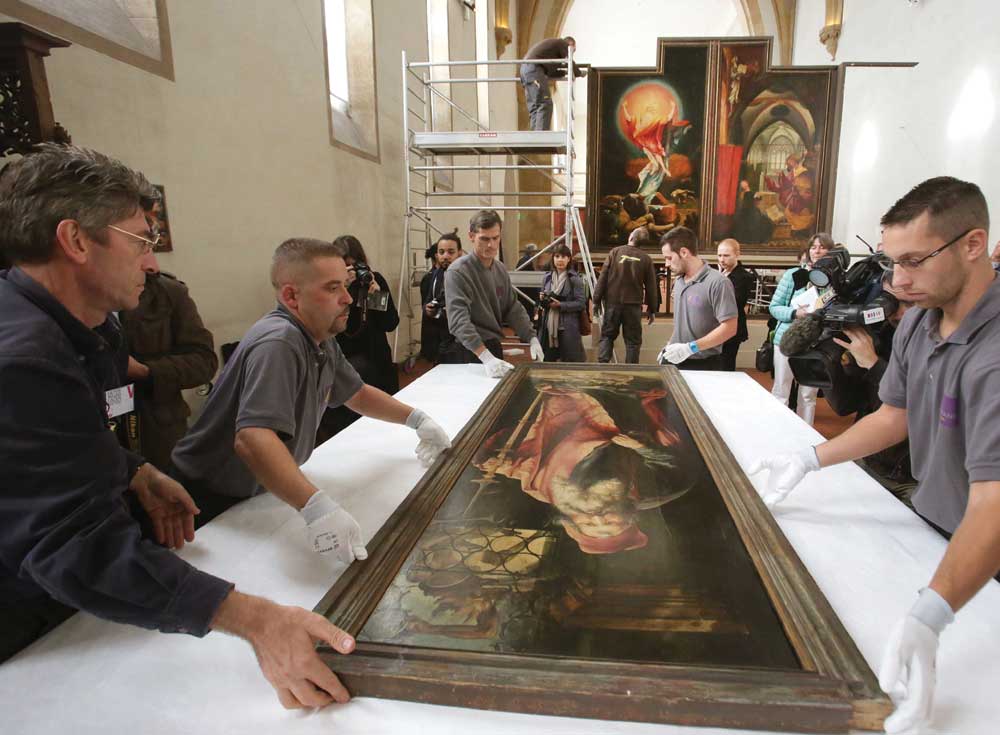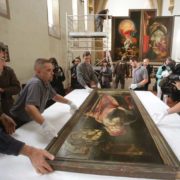The Isenheim Altarpiece: Yet Another Tale of Unauthorized Restoration in Colmar, France.
Ruth Osborne

Isenheim Altarpiece installed in Chapel of Musée d’Unterlinden, Colmar, France.
In 2011, the sixteenth-century Isenheim Altarpiece by German artist Mathis Gothart-Nithart underwent restoration. However, a report last month in The Art Newspaper describes the treatment as both unauthorized and performed in an “unorthodox” manner.[1] This, as well as the events leading up to the altarpiece’s restoration, have recently revealed controversy and division rife within the ranks of the French restoration establishment and government-sponsored conservation efforts.
It all begins with a familiar story – an old building with a bad roof. The chapel at the Musée Unterlinden in Colmar, which previously housed the altarpiece, required serious attention; the state-supported museum was then enforced with the removal of the altarpiece by Centre de recherche et de restauration des musées de France (C2RMF), all in the interest of safety during the roof repairs. What followed was an unexpected restoration, the controversial nature of which stems from the fact that neither the government officials nor the scientists involved saw it as necessary. The Schongauer Society, the private Alsatian organization of civil society volunteers that operates the museum, gave the green light for the stripping of old varnish and subsequent revarnishing of the work.
What is most startling about the stripping of the Isenheim Altarpiece is that it took a mere six days to remove the varnish on one section of the rather large altarpiece.This was then followed by a “test” removal of the varnish on another portion of the work. In stark contrast is the span of 1-2 years it took Louvre conservators to lighten the varnish on Rembrandt’s Supper at Emmaus and Da Vinci’s Saint Anne. According to The Art Newspaper, “no specific scientific examination or evaluation was conducted before or during the 2011 intervention.”[2]
The disturbingly rash “conservation” treatment produced an appropriately troubled response from the public brought to the attention of French culture minister Frédéric Mitterrand. Mitterrand and his colleagues at the C2RMF (Centre de recherche et de restauration des musées de France), France’s main body of art conservators and restorers, have thus far observed the rapid, one might consider careless, work on the altarpiece. The yellowed varnish, found to be from 1946, has been mostly removed from the surface, and the C2RMF has exhibited fears that the solvent used could move towards the top layers of the paint. The Isenheim Altarpiece will now go before the C2RMF for a more thorough judgment. They are soon slated to issue a report on the current condition of the work, as well as recommendations for future treatment and preservation procedures only now necessary because of its recent stripping.

Portion of Isenheim Altarpiece handled by staff after being moved for transport.
Unfortunately, the story of the Isenheim Altarpiece has become a familiar occurrence; ArtWatch reported on the unauthorized “conservation” treatment of eighteenth-century Qing Dynasty frescos (see here) in the Chinese province of Chaoyung earlier this year, while last year the world was stunned by the “restorative” work of Cecilia Gimenez (see here). According to our news source, there are two separated camps surrounding this restoration: “those who think restoration should be based on scientific studies and the old school, who have faith in experience and resent the criticism of their colleagues by the media. The French authorities have never managed to provide a technical framework or protocol for restoration in museums, but with tensions running high on all fronts, the Isenheim project is unlikely to bring this any closer.”[3] If anything, the quick work of the conservators’ hands, behind the back of the CDRMF’s authority, relates the explicit need for greater strictures on works considered for treatment. If there is no specific framework, set out by the scientific guidelines conservators so claim to rely on and benefit from, then how many works will suffer from half-done ill-performed treatments?
[1] Vincent Noce, “French fall-out over restoration: Museum’s treatment of Isenheim Altarpiece exposes rifts in French attitudes towards the care of the country’s cultural treasures,” The Art Newspaper. Issue 252, December 2013. http://www.theartnewspaper.com/articles/French-fallout-over-restoration/31094 (last accessed 7 December 2013)
[2] Ibid.
[3] Ibid.

